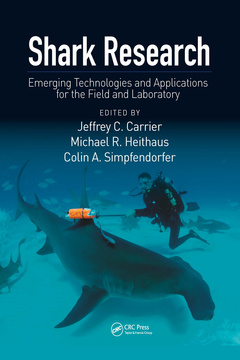Description
Shark Research
Emerging Technologies and Applications for the Field and Laboratory
CRC Marine Biology Series
Coordinators: Carrier Jeffrey C, Heithaus Michael R., Simpfendorfer Colin A.
Language: English
Subject for Shark Research:
Keywords
Whale Shark; Elasmobranchs; Blacktip Reef Sharks; Fisheries management; Lemon Sharks; Imaging and underwater video approaches; Ginglymostoma Cirratum; Acoustic telemetry and monitoring; Acoustic Telemetry; Spatial ecology and behavior; White Sharks; Trophic interactions; Nurse Sharks; Reef Sharks; Acoustic Receiver; Band Pairs; Blacktip Shark; Tiger Sharks; Case Study; Oceanic Whitetip Shark; Gray Reef Sharks; Sand Tiger Sharks; DNA Forensic; Cetorhinus Maximus; Dermal Denticles; Satellite Tags; Citizen Science Projects; Shark Species; Underwater Visual Censuses; DNA Barcoding; Rhincodon Typus
Publication date: 03-2020
· 21x28 cm · Paperback
Publication date: 09-2018
· 21x28 cm · Hardback
Description
/li>Contents
/li>Readership
/li>Biography
/li>
Over the last decade, the study of shark biology has benefited from the development, refinement, and rapid expansion of novel techniques and advances in technology. These have given new insight into the fields of shark genetics, feeding, foraging, bioenergetics, imaging, age and growth, movement, migration, habitat preference, and habitat use. This pioneering book, written by experts in shark biology, examines technologies such as autonomous vehicle tracking, underwater video approaches, molecular genetics techniques, and accelerometry, among many others. Each detailed chapter offers new insights and promises for future studies of elasmobranch biology, provides an overview of appropriate uses of each technique, and can be readily extended to other aquatic fish and marine mammals and reptiles.
Including chapter authors who were pioneers in developing some of the technologies discussed in the book, this book serves as the first single-source reference with in-depth coverage of techniques appropriate for the laboratory and field study of sharks, skates, and rays. It concludes with a unique section on Citizen Science and its application to studies of shark biology.
This is a must-read for any marine biologist or scientist working in the field of shark biology, as well as marine biology students and graduates.
Chapter 1 Dietary Biomarkers in Shark Foraging and Movement Ecology Chapter 2 Size-Based Insights into the Ecosystem Role of Sharks and Rays Chapter 3 Advances in the Application of High-Resolution Biologgers to Elasmobranch Fishes Chapter 4 Using Aerial Surveys to Investigate the Distribution, Abundance, and Behavior of Sharks and Rays Chapter 5 Animal-Borne Video Cameras and Their Use to Study Shark Ecology and Conservation Chapter 6 Use of Autonomous Vehicles for Tracking and Surveying of Acoustically Tagged Elasmobranchs Chapter 7 The Use of Stationary Underwater Video for Sampling Sharks Chapter 8 Acoustic Telemetry Chapter 9 Imaging Technologies in the Field and Laboratory Chapter 10 History and Mystery of Age and Growth Studies in Elasmobranchs: Common Methods and Room for Improvement Chapter 11 Near-Infrared Spectroscopy for Shark Ageing and Biology Chapter 12 Photographic Identification of Sharks Chapter 13 Genetics and Genomics for Fundamental and Applied Research on Elasmobranchs Chapter 14 Environmental DNA (eDNA): A Valuable Tool for Ecological Inference and Management of Sharks and Their Relatives Chapter 15 Shark CSI・The Application of DNA Forensics to Elasmobranch Conservation Chapter 16 Citizen Science in Shark and Ray Research and Conservation: Strengths, Opportunities, Considerations, and Pitfalls Chapter 17 Social Science and Its Application to the Studies of Shark Biology Chapter 18 Network Analysis and Theory in Shark Ecology・Methods and Applications Chapter 19 Satellite Tracking Technologies and Their Application to Shark Movement Ecology




